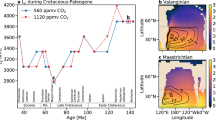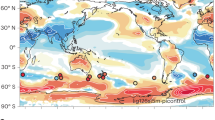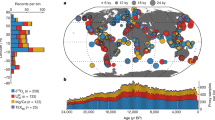Abstract
The climate of the tropics and surrounding regions is defined by pronounced zonal (east–west) and meridional (equator to mid-latitudes) gradients in sea surface temperature. These gradients control zonal and meridional atmospheric circulations, and thus the Earth’s climate. Global cooling over the past five million years, since the early Pliocene epoch, was accompanied by the gradual strengthening of these temperature gradients. Here we use records from the Atlantic and Pacific oceans, including a new alkenone palaeotemperature record from the South Pacific, to reconstruct changes in zonal and meridional sea surface temperature gradients since the Pliocene, and assess their connection using a comprehensive climate model. We find that the reconstructed zonal and meridional temperature gradients vary coherently over this time frame, showing a one-to-one relationship between their changes. In our model simulations, we systematically reduce the meridional sea surface temperature gradient by modifying the latitudinal distribution of cloud albedo or atmospheric CO2 concentration. The simulated zonal temperature gradient in the equatorial Pacific adjusts proportionally. These experiments and idealized modelling indicate that the meridional temperature gradient controls upper-ocean stratification in the tropics, which in turn controls the zonal gradient along the equator, as well as heat export from the tropical oceans. We conclude that this tight linkage between the two sea surface temperature gradients posits a fundamental constraint on both past and future climates.
This is a preview of subscription content, access via your institution
Access options
Subscribe to this journal
Receive 12 print issues and online access
$259.00 per year
only $21.58 per issue
Buy this article
- Purchase on Springer Link
- Instant access to full article PDF
Prices may be subject to local taxes which are calculated during checkout




Similar content being viewed by others
References
Philander, S. G. El Niño, La Niña, and the Southern Oscillation (Academic Press, 1990).
Fedorov, A. et al. Patterns and mechanisms of early Pliocene warmth. Nature 496, 43–49 (2013).
Pagani, M., Liu, Z., LaRiviere, J. & Ravelo, A. High Earth-system climate sensitivity determined from Pliocene carbon dioxide concentrations. Nature Geosci. 3, 27–30 (2010).
Medina-Elizalde, M., Lea, W. D. & Fantle, M. Implications of seawater Mg/Ca variability for Plio-Pleistocene climate reconstruction. Earth Planet. Sci. Lett. 269, 584–594 (2008).
Dekens, P., Ravelo, A. & McCarthy, M. Warm upwelling regions in the Pliocene warm period. Paleoceanography 22, PA3211 (2007).
Dekens, P. S., Ravelo, A. C., McCarthy, M. D. & Edwards, C. A. A 5 million year comparison of Mg/Ca and alkenone paleothermometers. Geochem. Geophys. Geosyst. 9, Q10001 (2008).
Zhang, Y. G. et al. A 12-million-year temperature history of the tropical Pacific Ocean. Science 344, 84–87 (2014).
O’Brien, C. L. et al. High sea surface temperatures in tropical warm pools during the Pliocene. Nature Geosci. 7, 606–611 (2014).
Ravelo, A. C., Lawrence, K. T., Fedorov, A. V. & Ford, H. L. Comment on “A 12-million-year temperature history of the tropical Pacific Ocean”. Science 346, 1467 (2014).
Wara, M. W., Ravelo, A. C. & Margaret, D. L. Permanent El Niño-like conditions during the Pliocene warm period. Science 309, 758–761 (2005).
Ravelo, A. C., Dekens, P. & McCarthy, M. Evidence for El Niño-like conditions during the Pliocene. Geol. Soc. Am. Today 16, 4–11 (2006).
Brierley, C. M., Burls, N., Ravelo, A. C. & Fedorov, A. V. Pliocene warmth and gradients. Nature Geosci. 8, 419–420 (2015).
Philander, S. G. & Fedorov, A. V. Role of tropics in changing the response to Milankovich forcing some three million years ago. Paleoceanography 18, 1045 (2003).
Fedorov, A. V. et al. The Pliocene paradox (Mechanisms for a permanent El Niño). Science 312, 1437–1443 (2006).
Brierley, C. M. et al. Greatly expanded tropical warm pool and weakened hadley circulation in the early Pliocene. Science 323, 1714–1718 (2009).
Dijkstra, H. & Neelin, J. Ocean–atmosphere interaction and the tropical climatology. Part II: Why the Pacific cold tongue is in the east. J. Clim. 8, 1343–1359 (1995).
Jin, F. F. Tropical ocean–atmosphere interaction, the Pacific cold tongue, and the El Niño–Southern Oscillation. Science 274, 76–78 (1996).
Jin, F. F. A simple model for the Pacific cold tongue and ENSO. J. Atmos. Sci. 55, 2458–2469 (1998).
Wang, W. & McPhaden, M. J. The surface-layer heat balance in the equatorial Pacific Ocean. Part I: Mean seasonal cycle. J. Phys. Oceanogr. 29, 1812–1931 (1999).
Sun, D. & Liu, Z. Dynamic ocean–atmosphere coupling: A thermostat for the tropics. Science 272, 1148–1149 (1996).
Clement, A., Seager, R. & Murtugudde, R. Why are there tropical warm pools? J. Clim. 18, 5294–5311 (2005).
McCreary, J. P. J. & Lu, P. Interaction between the subtropical and the equatorial oceans: The subtropical cell. J. Phys. Oceanogr. 24, 466–497 (1994).
Gu, D. & Philander, S. Interdecadal climate fluctuations that depend on exchanges between the tropics and extratropics. Science 275, 805–807 (1997).
Liu, Z. & Huang, B. A coupled theory of tropical climatology: Warm pool, cold tongue, and Walker circulation. J. Clim. 10, 1662–1679 (1997).
Liu, Z. & Yang, H. Extratropical control of tropical climate, the atmospheric bridge and oceanic tunnel. Geophys. Res. Lett. 30, PA1230 (2003).
Boccaletti, G. et al. The thermal structure of the upper ocean. J. Phys. Oceanogr. 34, 888–902 (2004).
Burls, N. J. & Fedorov, A. V. What controls the mean east–west sea surface temperature gradient in the equatorial Pacific: The role of cloud albedo. J. Clim. 27, 2757–2778 (2014).
Martínez-Garcia, A. et al. Subpolar link to the emergence of the modern equatorial Pacific cold tongue. Science 328, 1550–1553 (2010).
Merlis, T. & Schneider, T. Changes in zonal surface temperature gradients and Walker circulations in a wide range of climates. J. Clim. 24, 4757–4768 (2011).
Fedorov, A. V. & Philander, S. G. A stability analysis of tropical ocean–atmosphere interactions: Bridging measurements and theory for El Niño. J. Clim. 14, 3086–3101 (2001).
Burls, N. J. & Fedorov, A. V. Simulating Pliocene warmth and a permanent El Niño-like state: The role of cloud albedo. Paleoceanography 29, 893–910 (2014).
Ford, H. L. et al. The evolution of the equatorial thermocline and the early Pliocene El Padre mean state. Geophys. Res. Lett. 42, 4878–4887 (2015).
Cane, M. & Molnar, P. Closing of the Indonesian seaway as a precursor to east African aridification around 3–4 million years ago. Nature 411, 157–162 (2001).
Zhang, X. et al. Changes in equatorial Pacific thermocline depth in response to Panamanian seaway closure: Insights from a multi-model study. Earth Planet. Sci. Lett. 317, 76–84 (2012).
Haywood, A. M. et al. Large-scale features of Pliocene climate: Results from the Pliocene Model Intercomparison Project. Clim. Past. 9, 191–209 (2013).
Barreiro, M. & Philander, S. G. Response of the tropical Pacific to changes in the extra-tropical clouds. Clim. Dynam. 31, 713–729 (2008).
Müller, P. J., Kirst, G., Ruhland, G., von Storch, I. & Rosell-Melé, A. Calibration of the alkenone paleotemperature index Uk′37 on core-tops from the eastern South Atlantic and the global ocean (60° N–60° S). Geochim. Cosmochim. Acta 62, 1757–1772 (1998).
Harper, S. Thermocline ventilation and pathways of tropical–subtropical water mass exchange. Tellus A 52, 330–345 (2000).
Shipboard Scientific Party in Proc. ODP, Init. Rep. 181 (eds Carter, R. M. et al.) (ODP, 1999).
Brassell, S. C., Eglinton, G., Marlowe, I. T., Pflaumann, U. & Sarnthein, M. Molecular stratigraphy: A new tool for climatic assessment. Nature 320, 129–133 (1986).
Prahl, F. G. & Wakeham, S. G. Calibration of unsaturation patterns in long-chain ketone compositions for palaeotemperature assessment. Nature 330, 367–369 (1987).
Volkman, J. K., Eglinton, G., Corner, E. D. S. & Sargent, J. R. in Advances in Organic Geochemistry (eds Douglas, A. G. & Maxwell, J. R.) 219–227 (Pergamon Press, 1980).
Prahl, F. G., de Lange, G. J., Lyle, M. & Sparrow, M. A. Post-depositional stability of long-chain alkenones under contrasting redox conditions. Nature 341, 434–437 (1989).
Lawrence, K. T., Sosdian, S., White, H. E. & Rosenthal, Y. North Atlantic climate evolution through the Plio-Pleistocene climate transitions. Earth Planet. Sci. Lett. 300, 329–342 (2010).
Liu, Z. & Herbert, T. High-latitude influence on the eastern equatorial Pacific climate in the early Pleistocene epoch. Nature 427, 720–723 (2004).
Lawrence, K., Liu, Z. & Herbert, T. Evolution of the eastern tropical Pacific through Plio-Pleistocene glaciation. Science 312, 79–83 (2006).
Lawrence, K., Herbert, T., Brown, C., Raymo, M. & Haywood, A. High-amplitude variations in north Atlantic sea surface temperature during the early Pliocene warm period. Paleoceanography 24, PA2218 (2009).
LaRiviere, J. et al. Late Miocene decoupling of oceanic warmth and atmospheric carbon dioxide forcing. Nature 486, 97–100 (2012).
Martínez-Garcia, A. et al. Links between iron supply, marine productivity, sea surface temperature, and CO2 over the last 1.1 Ma. Paleoceanography 24, PA1207 (2009).
Etourneau, J., Martinez, P., Blanz, T. & Schneider, R. Intensification of the Walker and Hadley atmospheric circulations during the Pliocene–Pleistocene climate transition. Earth Planet. Sci. Lett. 297, 103–110 (2010).
de Garidel-Thoron, T., Rosenthal, Y., Bassinot, F. & Beaufort, L. Stable sea surface temperatures in the western Pacific warm pool over the past 1.75 million years. Nature 433, 294–298 (2005).
Dowsett, H. J., Robinson, M. M., Stoll, D. K. & Foley, K. M. Mid-Piacenzian mean annual sea surface temperature analysis for data-model comparisons. Stratigraphy 7, 189–198 (2010).
Seki et al. Paleoceanographic changes in the eastern equatorial Pacific over the last 10 Myr. Paleoceanography 27, PA3224 (2012).
McClymont, E. L. et al. Sea-surface temperature records of Termination 1 in the Gulf of California: Challenges for seasonal and inter-annual analogues of tropical Pacific climate change. Paleoceanography 27, PA2202 (2012).
Petrick, B. et al. Late Pliocene upwelling in the Southern Benguela region. Palaeogeogr. Palaeoclimatol. Palaeoecol. 429, 62–71 (2015).
Shields, C. et al. The low-resolution CCSM4. J. Clim. 25, 3993–4014 (2012).
Kiehl, J. & Shields, C. Sensitivity of the Paleocene–Eocene thermal maximum climate to cloud properties. Phil. Trans. R. Soc. A 371, 20130093 (2014).
Kump, L. & Pollard, D. Amplification of Cretaceous warmth by biological cloud feedbacks. Science 320, 195–195 (2008).
Rose, B. E. J. & Ferreira, D. Ocean heat transport and water vapor greenhouse in a warm equable climate: A new look at the low gradient paradox. J. Clim. 26, 2117–2136 (2013).
Sun, D.-Z. & Oort, A. H. Humidity-temperature relationships in the tropical troposphere. J. Clim. 8, 1974–1987 (1995).
Jansen, M. & Ferrari, R. Impact of the latitudinal distribution of tropical cyclones on ocean heat transport. Geophys. Res. Lett. 36, L06604 (2009).
Fedorov, A. V., Brierley, C. M. & Emanuel, K. Tropical cyclones and permanent El Niño in the early Pliocene epoch. Nature 463, 1066–1070 (2010).
Manucharyan, G., Brierley, C. & Fedorov, A. Climate impacts of intermittent upper ocean mixing induced by tropical cyclones. J. Geophys. Res. 116, C11038 (2011).
Tziperman, E. & Farrell, B. Pliocene equatorial temperature: Lessons from atmospheric superrotation. Paleoceanography 24, PA1101 (2009).
Caballero, R. & Huber, M. Spontaneous transition to superrotation in warm climates simulated by CAM3. Geophys. Res. Lett. 37, L11701 (2010).
Fedorov, A. V., Barreiro, M., Boccaletti, G., Pacanowski, R. & Philander, S. G. The freshening of surface waters in high latitudes: Effects on the thermohaline and wind-driven circulations. J. Phys. Oceanogr. 37, 896–907 (2007).
Fedorov, A. V., Pacanowski, R., Philander, S. & Boccaletti, G. The effect of salinity on the wind-driven circulation and the thermal structure of the upper ocean. J. Phys. Oceanogr. 34, 1949–1966 (2004).
Hotinski, R. & Toggweiler, J. Impact of a Tethyan circumglobal passage on ocean heat transport and ‘equable’ climates. Paleoceanography 18, 1007 (2003).
Enderton, D. & Marshall, J. Explorations of atmosphere-ocean-ice climates on an aquaplanet and their meridional energy transports. J. Atmos. Sci. 66, 1593–1611 (2009).
Acknowledgements
Financial support was provided by grants from the US Department of Energy Office of Science (DE-SC0007037), NSF (AGS-1405272), NSF (OCE-1304366), NOAA (NA14OAR4310277) and the David and Lucile Packard Foundation. The CESM project is supported by the National Science Foundation and the Department of Energy Office of Science. Support from the Yale University Faculty of Arts and Sciences High Performance Computing facility is acknowledged. We thank C. Brierley, S. Hu, C. Ravelo and G. Philander for discussions of this topic and B. Dobbins for help in setting up the CESM simulations. We are indebted to C. Riihimaki for help with making the SST map for Fig. 1 of the paper.
Author information
Authors and Affiliations
Contributions
A.V.F. and N.J.B. contributed equally to the writing and ideas of this manuscript. N.J.B. conducted numerical experiments with CESM and, together with A.V.F., analysed the experimental results. K.T.L. and L.C.P. generated the new SST record at ODP site 1125 and contributed to the writing of the paper.
Corresponding author
Ethics declarations
Competing interests
The authors declare no competing financial interests.
Supplementary information
Supplementary Information
Supplementary Information (PDF 2425 kb)
Supplementary Information
Supplementary Information (XLSX 53 kb)
Rights and permissions
About this article
Cite this article
Fedorov, A., Burls, N., Lawrence, K. et al. Tightly linked zonal and meridional sea surface temperature gradients over the past five million years. Nature Geosci 8, 975–980 (2015). https://doi.org/10.1038/ngeo2577
Received:
Accepted:
Published:
Issue Date:
DOI: https://doi.org/10.1038/ngeo2577
This article is cited by
-
Low-frequency orbital variations controlled climatic and environmental cycles, amplitudes, and trends in northeast Africa during the Plio-Pleistocene
Communications Earth & Environment (2023)
-
Intermediate water circulation drives distribution of Pliocene Oxygen Minimum Zones
Nature Communications (2023)
-
Subtropical drying under greenhouse gas-induced warming
Climate Dynamics (2023)
-
Sustained mid-Pliocene warmth led to deep water formation in the North Pacific
Nature Geoscience (2022)
-
Climate evolution of southwest Australia in the Miocene and its main controlling factors
Science China Earth Sciences (2022)



